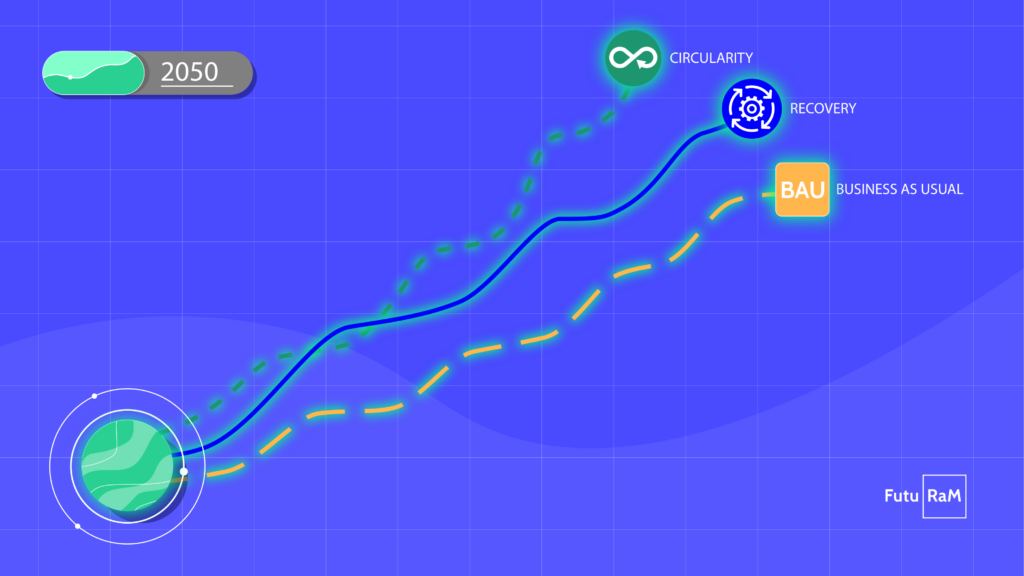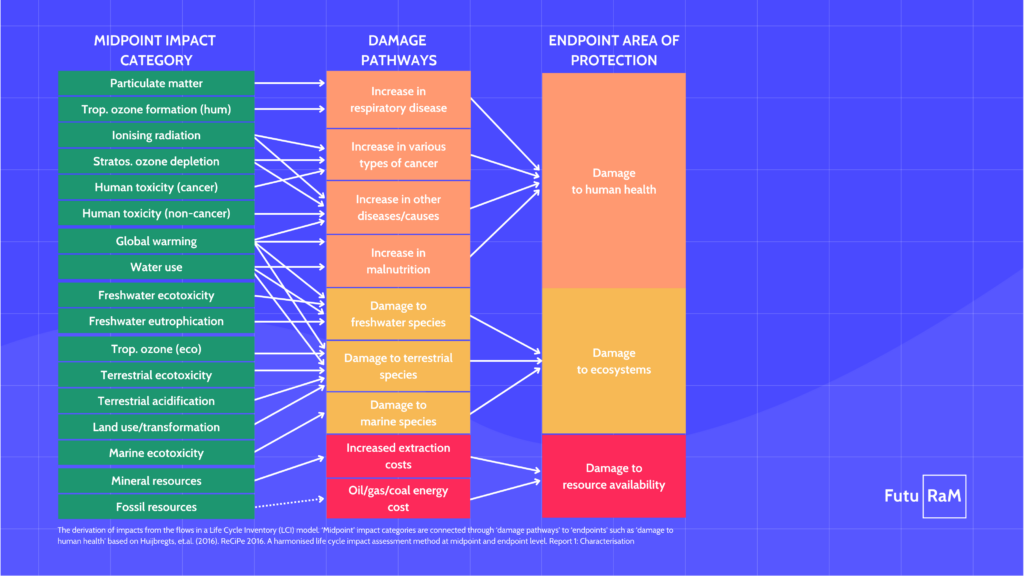A Technical Brief from FutuRaM. Brought to by Stewart Charles McDowall from Leiden University.

Key Points
- The FutuRaM Project: Data collection and modelling to map out the terrain of the future resource landscape under different scenarios.
- Life Cycle Assessment (LCA): A method from Industrial Ecology that can model the impacts of a product’s supply chain and end-of-life/recovery including environmental, economic, and social effects.
- Main Steps in LCA:
- Inventory: Compile all flows between production and the environment.
- Impact Assessment: Estimate how these exchanges affect the planet and society.
- Utility of LCA: To help us to make choices that are better for nature and society by finding where the biggest impacts occur.
2RMs, CRMs, and the “Circular Economy“
By definition, the development of the “circular economy” necessitates the reduction and ultimate elimination of waste — though whether this is thermodynamically possible has long been the subject of fierce debate. In any case, minimising primary material consumption and the generation of waste is of paramount importance.
While the linear model — take, make, dispose — remains dominant, it’s increasingly clear this path is unsustainable. The circular economy, with its focus on utilising secondary raw materials (2RMs) and promoting social and environmental values, promises a much brighter future. Moreover, in the context of a mineral-hungry renewable energy transition and constant geopolitical tensions, more attention is being paid to the security of material supply, especially for those considered ‘critical raw materials’ (CRMs).
With a keen eye on these 2RMs and CRMs, the FutuRaM project is mapping out the terrain of what our future resource landscape might look like. One of FutuRaM’s ambitious goals is to compare the impacts of our current economic modes with those forecast in three potential future scenarios: “business as usual”, “recovery”, and “circularity”.
Comparing Impacts with Life Cycle Assessment

Every human activity generates a spectrum of externalities, impacting the environment, economy, and society — the so-called “pillars of sustainability“. Assessing these impacts, especially their long-term implications, presents a formidable challenge. However, this analysis is crucial for guiding more sustainable practices. Life Cycle Assessment (LCA) stands out as a valuable tool in this endeavour, leveraging knowledge of supply chains and end-of-life fates to offer a detailed examination of both the direct and indirect effects of our activities.
LCA evaluates impacts across a product’s entire life cycle — ideally, with a mindset shifting from ‘cradle-to-grave’, to ‘cradle-to-cradle’. With a holistic examination, from raw material extraction, processing, manufacture, distribution, use, repair, and maintenance, through to disposal or recycling, LCA can help us understand and minimise our ecological footprint as well as other social and economic outcomes.

An LCA model is built on an inventory of the exchanges between the “technosphere” and the ‘biosphere’, the flows between the human and natural world (see Figure 1). Each of these exchanges (e.g., CO2 to air or cobalt from soil) is characterised by a set of impact factors (e.g., climate change or resource depletion), which are based on general — or ideally, location and time specific — models that incorporate knowledge from a variety of fields such as meteorology and environmental toxicology (see Figure 2). The final result is a Life Cycle Impact Assessment (LCIA), which attempts to describe the total impacts of a product or service.
Waste Generation and Material Demand in Life Cycle Assessment
Accurate and detailed information about waste and waste systems is, by definition, essential for understanding the “circularity” of a human activity and predicting its life cycle externalities. There remains, however, a conspicuous knowledge gap regarding the waste and material footprints of human activities and their environmental impacts. The environmental significance of waste and its correlation with other indicators has been the subject of extensive research and studies have shown that popular resource footprints can cover a significant portion of environmental impact variance between activities.
To help fill these knowledge gaps my colleagues at Leiden University and I have developed a program named “T-reX” to extend the existing computational framework of LCA by facilitating the quantification of waste and material flows in LCA. T-reX is short for “Tool re-X” (recycling, reuse, etc.), and this name was coined during a “futures thinking” small group session at the June 2023 FutuRaM consortium meeting in Berlin. A publication describing the T-reX is currently under review.
The purpose of the T-reX is not to quantify the environmental impacts of material consumption and waste production but rather to quantify the material and waste flows themselves. It provides, thus, not an impact assessment in the traditional sense, but an accounting of the material consumed, and waste generated by a product or service inside of the technosphere, regardless of the end-of-life fate of these flows. By allowing LCA practitioners to easily classify and quantify these exchanges, T-reX can provide a practical means to highlight opportunities for waste reduction and material efficiency.
Promoting Circularity with LCA in FutuRaM
The quintessential principle of the “circular economy” is to minimise material consumption and waste generation. Thus, identifying and quantifying waste and material flows are of fundamental importance. Life Cycle Assessment is a powerful method for this, given its capacity to pinpoint hotspots of environmental impact throughout the life cycle of activities, where the implementation of circular principles could be most effective.
Like all methods, however, the utility of LCA models depends greatly on the quality of their underlying datasets. By collecting and analysing data on the flow of secondary raw materials within the economy, projects like FutuRaM play a pivotal role in strengthening our knowledge base. The information that FutuRaM is producing regarding material flows and process conditions will feed into our (and other) LCA models, enhancing the precision of assessments, and thus the sustainability strategies.
With a strong foundation of high-quality data, we can use LCA to contrast the environmental, social, and economic impacts of a range of linear and circular economic models and provide valuable insights into the opportunities and trade-offs inherent in each system. This comparative analysis will be instrumental in shaping informed policy and decision-making processes that will, we hope, promote social and environmental good and help to guide humanity towards more sustainable practices.
